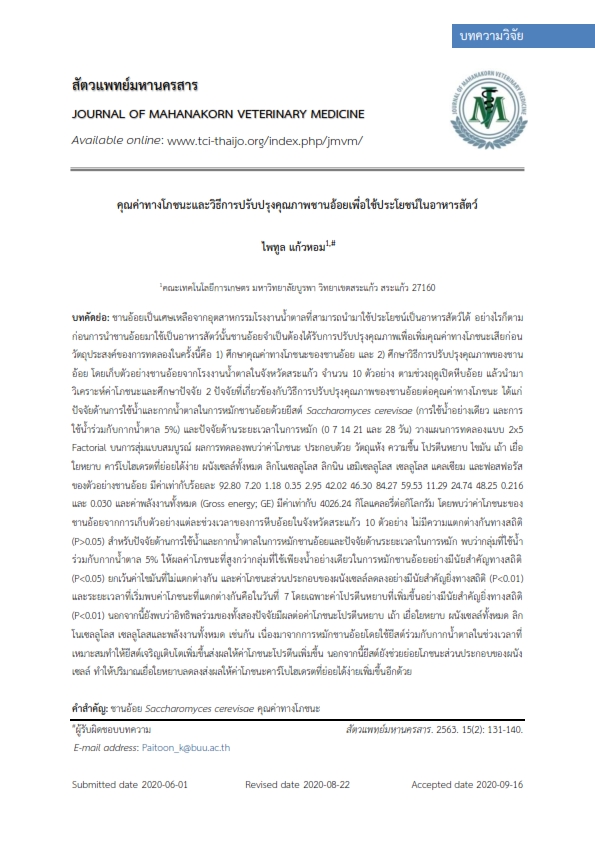Nutritive Value and Methods of Improving Sugarcane Bagasse Quality for Apply in Animal Feed
Main Article Content
Abstract
Sugarcane bagasse is waste from sugar mill industry that can be utilized as animal feed. However, before using sugarcane bagasse as animal feed, quality improvement was needed to increase nutritional value. The objectives of this experiment were 1) study on the nutritive value of sugarcane bagasse, and 2) study on methods for improving the quality of sugarcane bagasse. Sugarcane bagasse samples were collected in 10 samples from sugar mill in Sa Kaeo province by the sugarcane crushing season opens and then analyzed for nutritive values and studied 2 factors related to the method of improving sugarcane bagasse quality on nutrients were the water and molasses factors for sugarcane bagasse fermentation using Saccharomyces cerevisae yeast (water use only and water usage with 5% molasses), and the factors of the duration of fermentation (0 7 14 21 and 28 days). The fermented sugarcane bagasse was used in a factorial arrangement (2x5) based on a completely randomized design. The results demonstrated that the average percentage of nutritional values consisted of dry matter, moisture, crude protein, ether extract, ash, crude fiber, nitrogen free extract, neutral detergent fiber, acid detergent fiber, lignin, hemicellulose, cellulose, calcium and phosphorus was 92.80, 7.20, 1.18, 0.35, 2.95, 42.02, 46.30, 84.27, 59.53, 11.29, 24.74, 48.25, 0.216, 0.030, respectively and the gross energy was 4026.24 kcal/kg. It was found that the nutritive values of sugarcane bagasse from 10 samples collected in Sa Kaeo province (each period of sugarcane crushing) were not statistically different (P> 0.05). For the factor of water and molasses in bagasse fermentation and for the duration of fermentation, it was found that the group that used water with 5% molasses yielded higher nutritive values than used only water group for sugarcane bagasse fermentation with statistical significance (P<0.05). The time duration for finding the different nutritive values was found on the 7th day, especially the crude protein value which increased significantly (P<0.01). In addition, it was found that the interaction of these two factors affected the nutritive value of crude protein, ash, crude fiber, neutral detergent fiber, acid detergent fiber, cellulose, and gross energy as well. Due to the appropriate timing of fermentation of bagasse using yeast and molasses, the yeast growth increased, resulting in increased protein nutritional value. Additionally, yeast helps digest the cell wall, reducing the amount of crude fiber, resulting in an increase in the nitrogen free extract values.
Article Details
References
AOAC. 2012. Official method of analysis of association of official analysis chemists. 19th ed. Washington D.C.
Fatma, M.S., R. Salama, A. E. Khattab, S. M. Soliman, and Y. A. El-Nomeary. 2011. Chemical, biological, and biochemical treatments to improve the nutritive values of sugarcane bagasse (SCB): 1- Chemical composition, scanning electron microscopy, In Vitro evaluation, nutrients digestibility and nitrogen utilization of untreated or treated SCB. Life Sci. J. 8(4): 351-363.
Mohammed, H. A., A. B. Salih, M. A. Fadel Elseed, and M. A. Mohammed. 2013. Effect of urea-treatment on nutritive value of sugarcane bagasse. ARPN J. Sci. Technol. 3(8): 834-838.
National Energy Policy and Planning Office. 2002. Promoting the use of energy from biomass in Thailand. NEPO Journal. 55: 22-39.
Nirawan, A., M. Wannapat, P. Gunun, A. Cherdthong, and W. Kaewwongsa. 2014. Effect of sugarcane bagasse treatment on gas production and ruminal degradability by using in vitro gas production technique. Khon Kaen Agri. J. 42(4): 35-40.
Office of Cane and Sugar Board. 2019. Sugarcane planting area report, Production Year 2018-2019. Academic and information group for cane and sugar industry. Office of Cane and Sugar Board, Ministry of Industry.
Pimpa, W. and P. Napheerong. 2013. Development of bagasse fermentation with mixed microorganisms for use in chicken feed. Faculty of Agriculture, Natural Resources and Environment, Naresuan University.
Ramli, M. N., Y. Imura, K. Takayama, and Y. Nakanishi. 2005. Bioconversion of sugarcane bagasse with Japanese Koji by solid-state fermentation and its effects on nutritive value and preference in goats. Asian-Australasian J. Anim. Sci. 18(9): 1279-1284.
Suksombat, W. 2004. Comparison of different alkali treatment of bagasse and rice straw. Asian-Australasian J. Anim. Sci. 17(10): 1430-1433.
Van Soest, P. J., J. B. Robertson, and B. A. Lewis. 1970. Methods for dietary fiber, neutral detergent fiber, and nonstarch polysaccharides in relation to animal nutrition. J. Dairy Sci. 74: 3583-3597.


